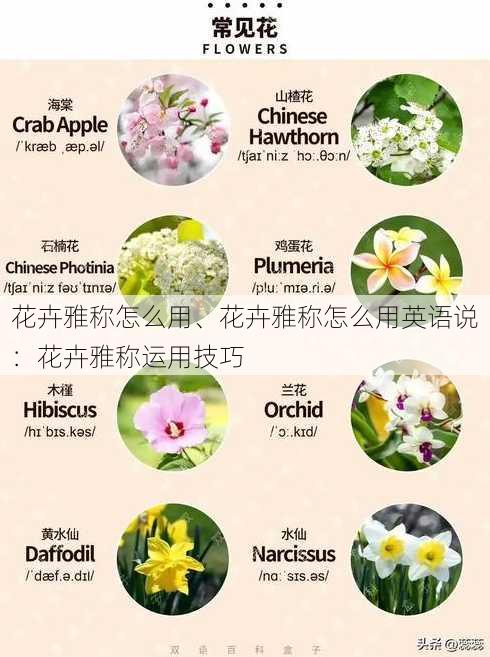| 题目 | 花卉雅称怎么用 | 花卉雅称怎么用英语说 | 花卉雅称运用技巧 |
|---|---|---|---|
| 一、花卉雅称的定义 | 花卉雅称是指对某些花卉的美丽和寓意进行诗意概括的名称,具有浓厚的文化内涵。 | The poetic names given to certain flowers, which embody their beauty and connotations with rich cultural connotations. | 理解花卉雅称背后的文化寓意,有助于提升语言表达的艺术性和文化内涵。 |
| 二、花卉雅称的运用场景 | 1. 赠送花卉时,使用雅称表达祝福;2. 文学创作中,以雅称丰富词汇,增添诗意;3. 园林设计中,以雅称命名花卉,提升景观文化氛围。 | 1. When giving flowers, use poetic names to express blessings; 2. In literary creation, enrich vocabulary with poetic names to add poetic flavor; 3. In garden design, name flowers with poetic names to enhance the cultural atmosphere of the landscape. | 了解不同场景下的花卉雅称运用,使表达更加得体、生动。 |
| 三、花卉雅称的运用技巧 | 1. 结合花卉的形态特征,选择合适的雅称;2. 考虑雅称的文化内涵,确保表达得体;3. 运用比喻、拟人等修辞手法,增强表达效果。 | 1. Combine the morphological characteristics of the flower with the appropriate poetic name; 2. Consider the cultural connotations of the poetic name to ensure appropriate expression; 3. Use metaphors, personification, and other rhetorical techniques to enhance the expression effect. | 精心挑选花卉雅称,结合具体情境进行运用,使表达更具艺术性和感染力。 |
| 四、花卉雅称的英语表达 | 1. 紫罗兰 - Violets (代表谦逊、忠诚);2. 牡丹 - Peonies (代表富贵、繁荣);3. 菊花 - Chrysanthemums (代表长寿、吉祥);4. 桂花 - Osmanthus (代表高洁、美好)。 | 1. Violets (represent modesty and loyalty); 2. Peonies (represent wealth and prosperity); 3. Chrysanthemums (represent longevity and good fortune); 4. Osmanthus (represent purity and beauty). | 学习花卉雅称的英语表达,拓宽国际交流中的语言表达方式。 |



文章版权声明:除非注明,否则均为教育生活网原创文章,转载或复制请以超链接形式并注明出处。
